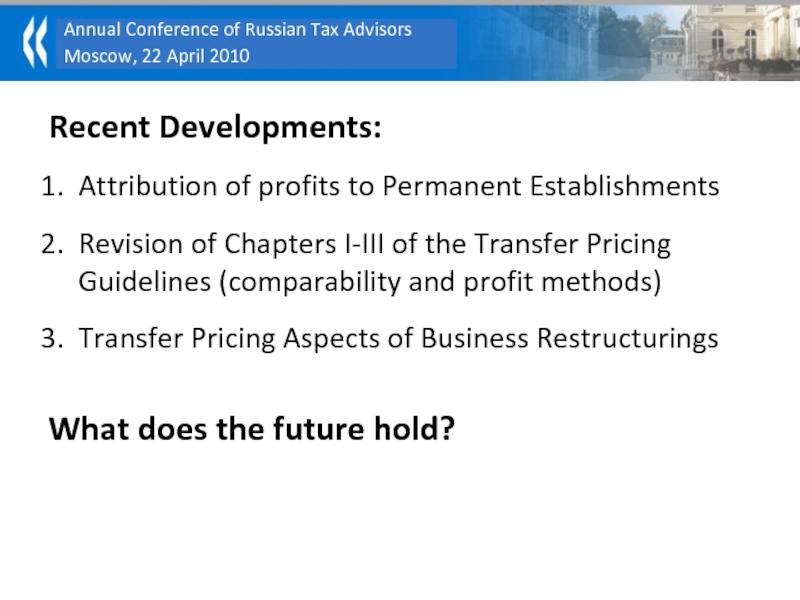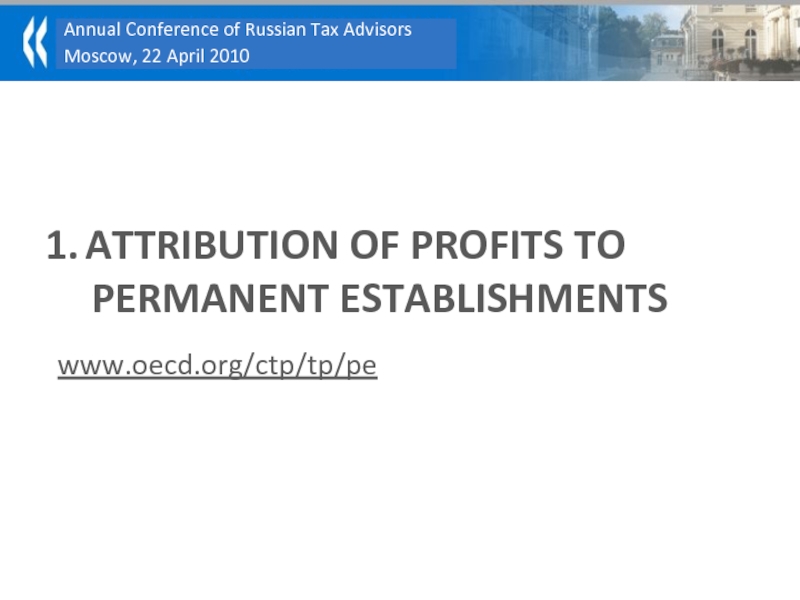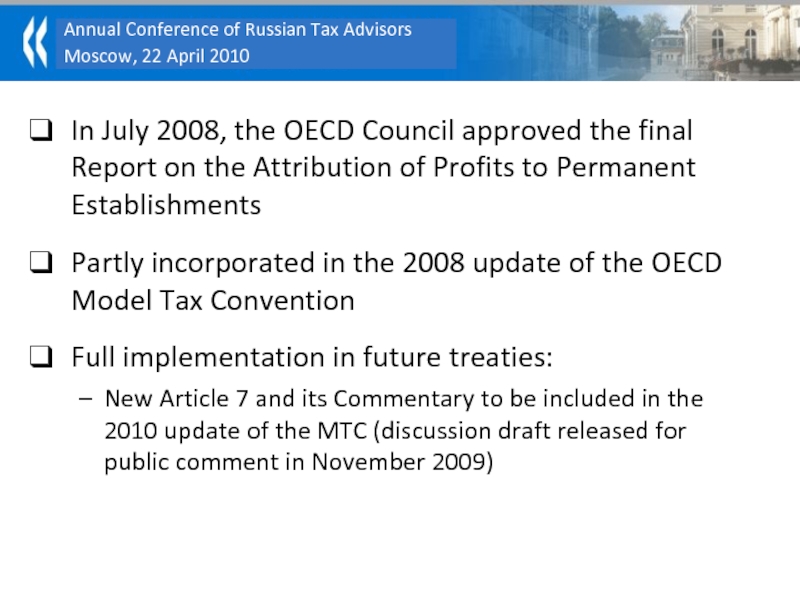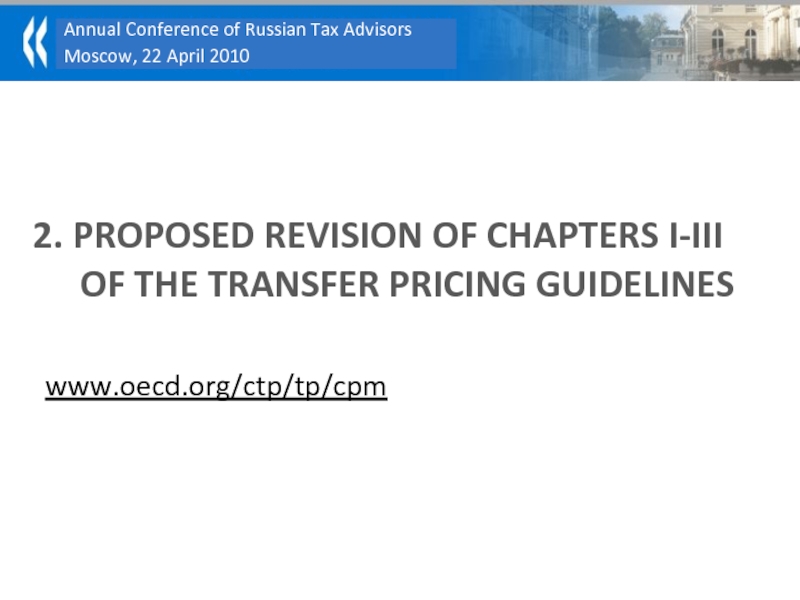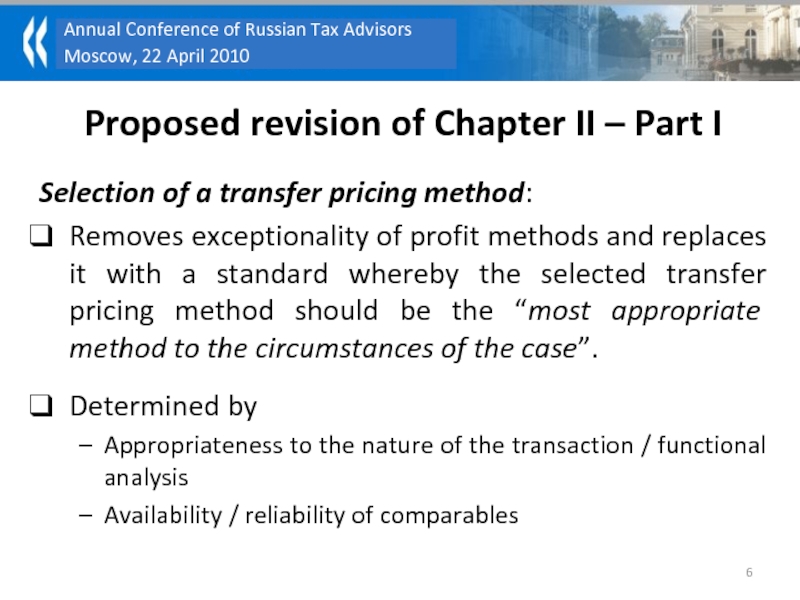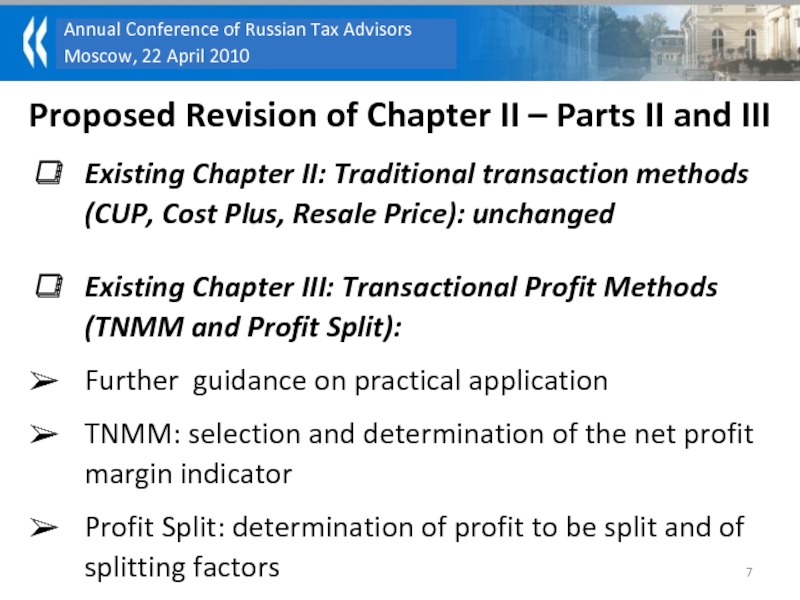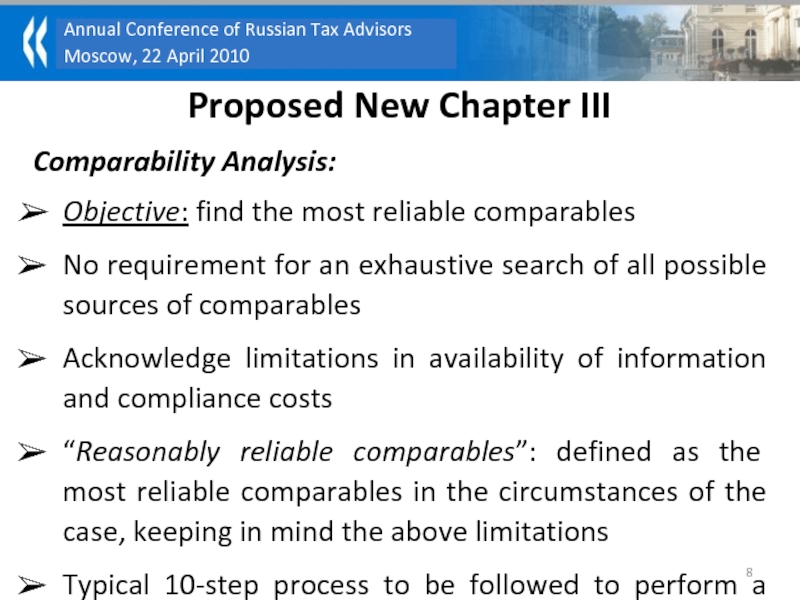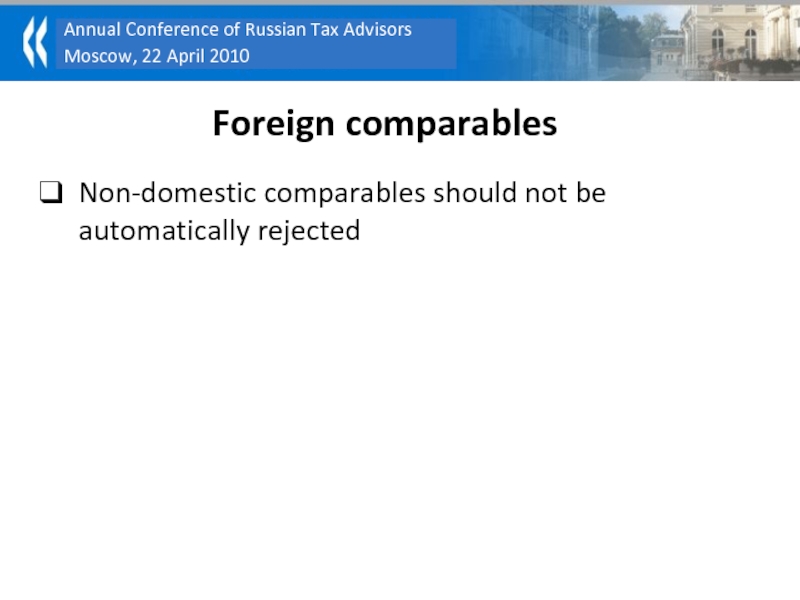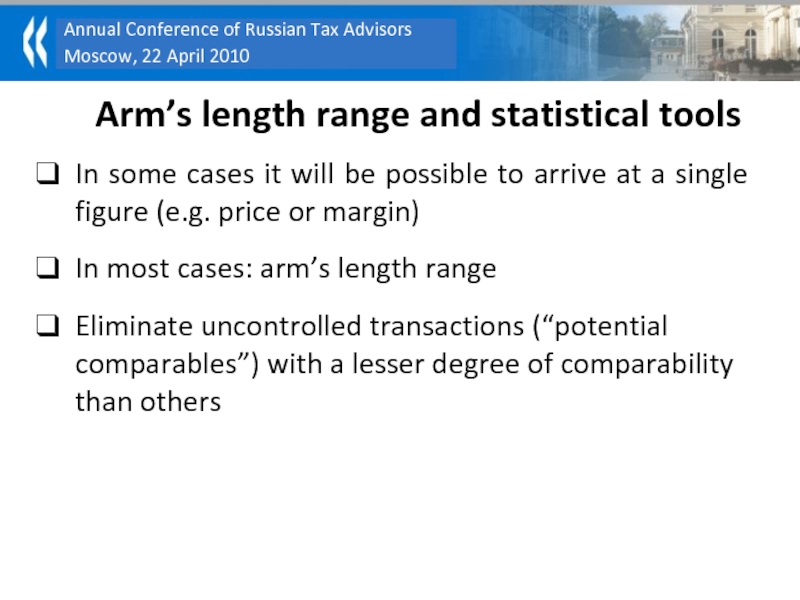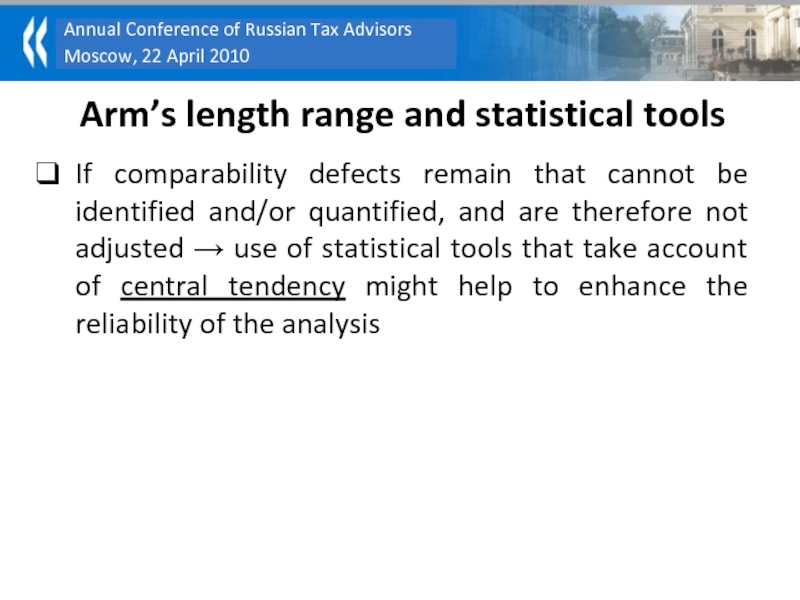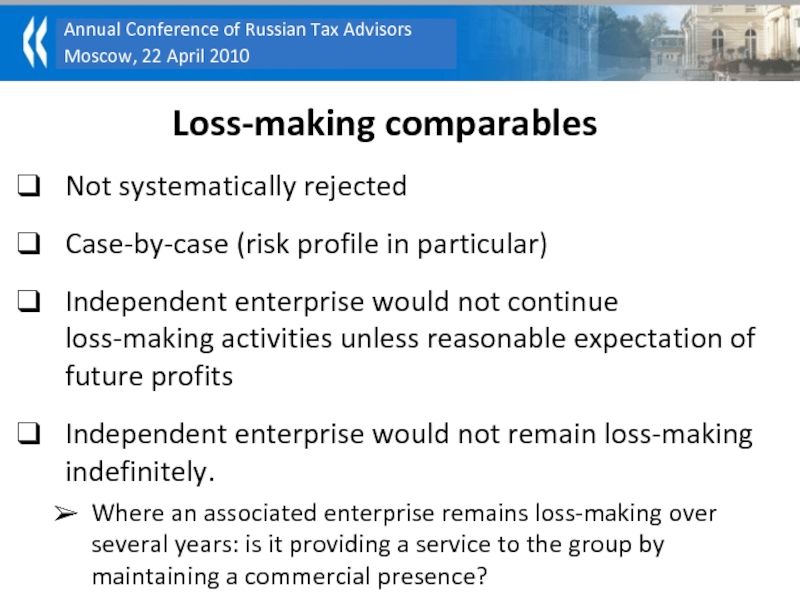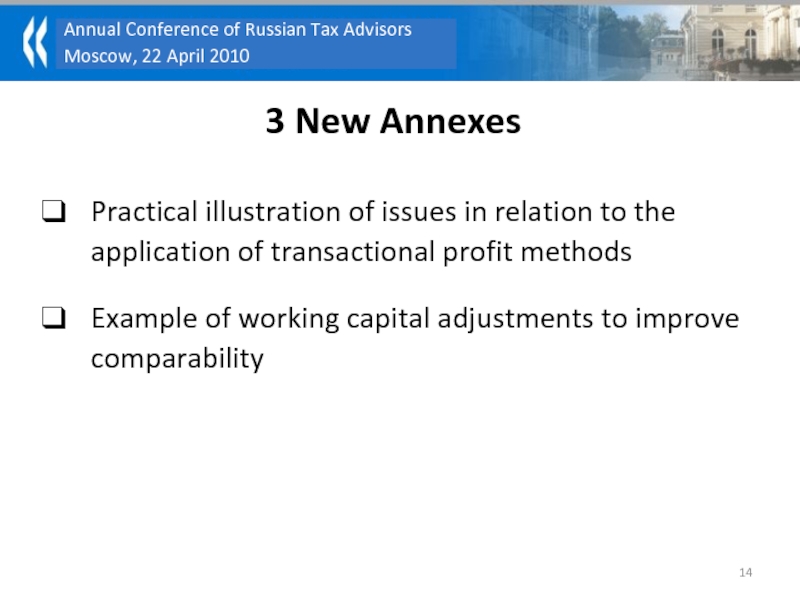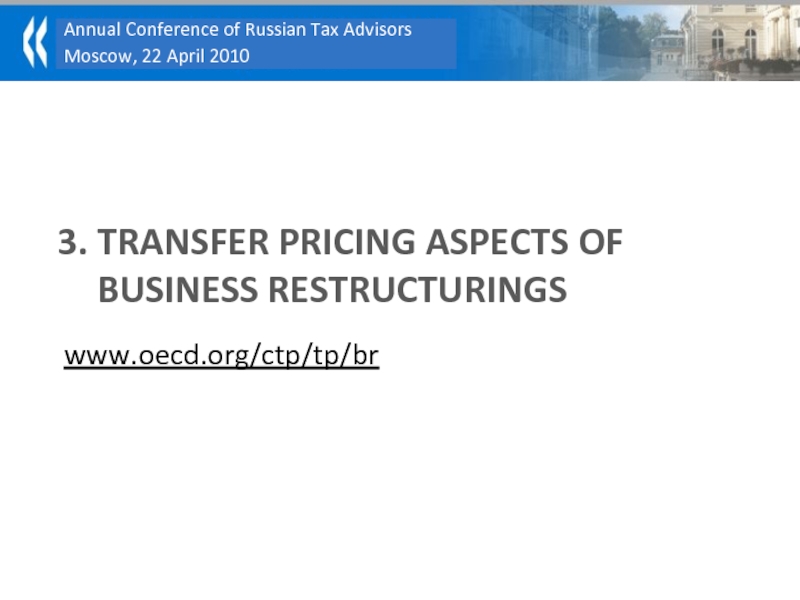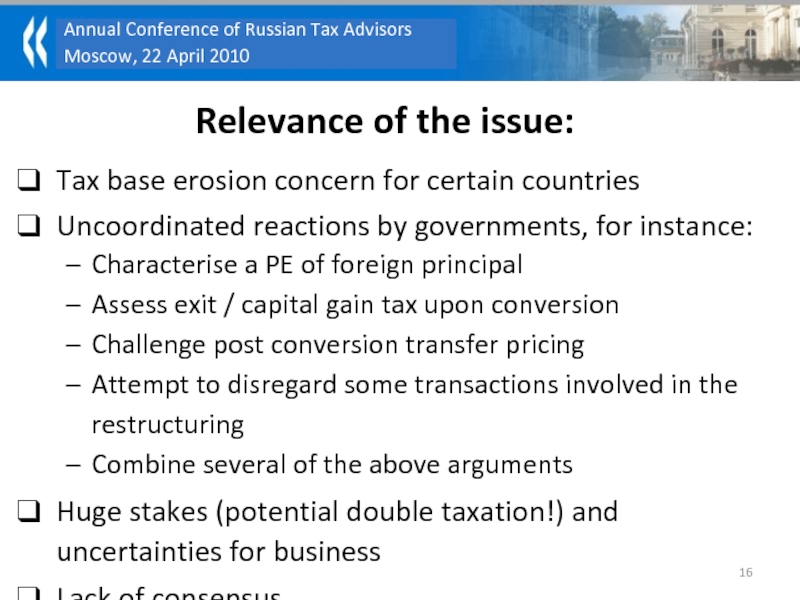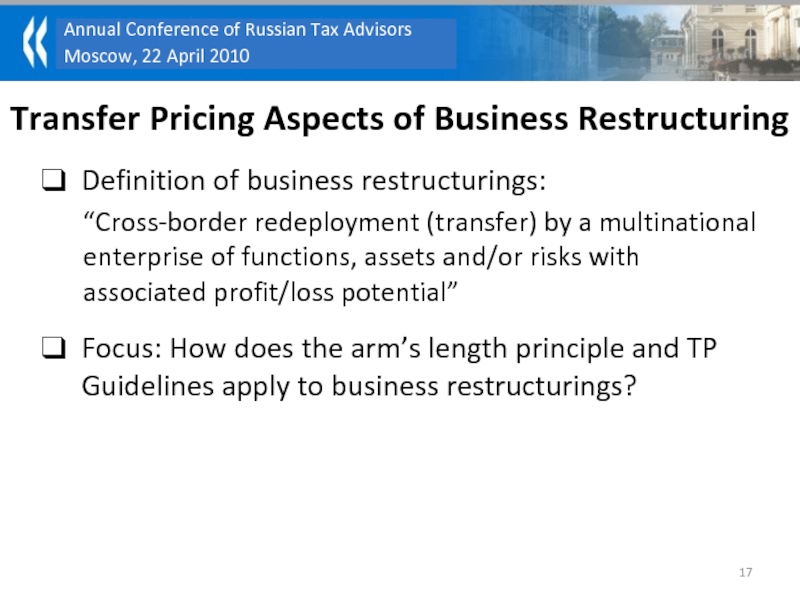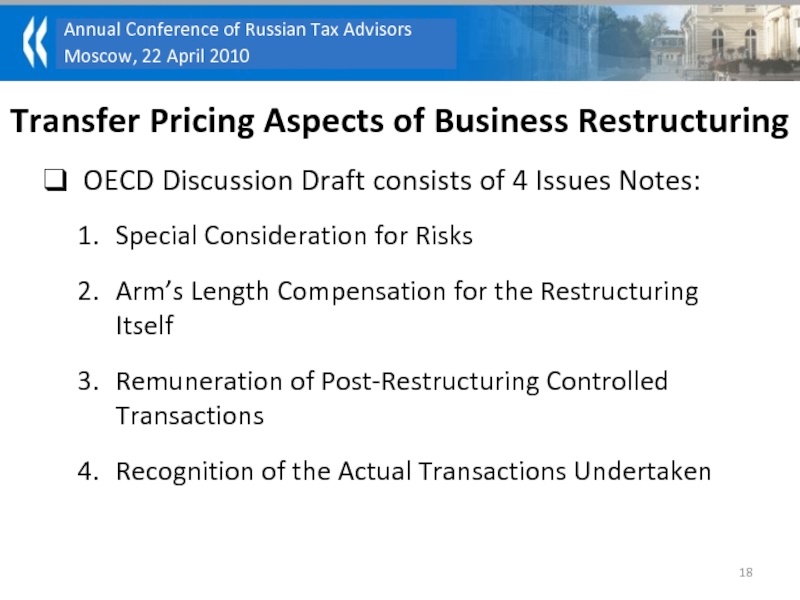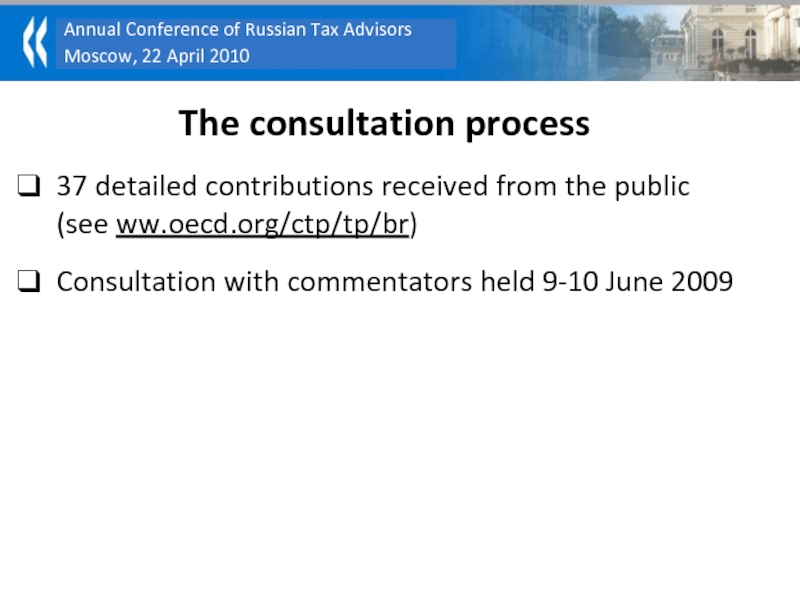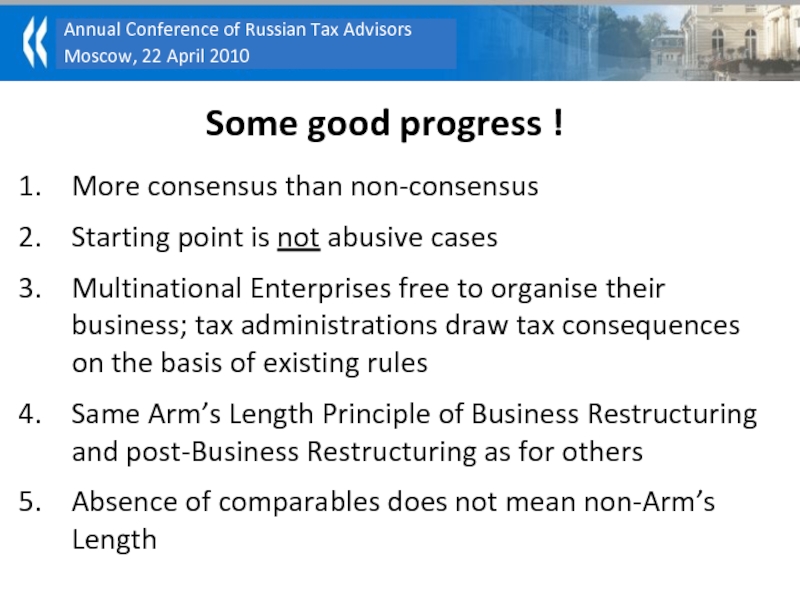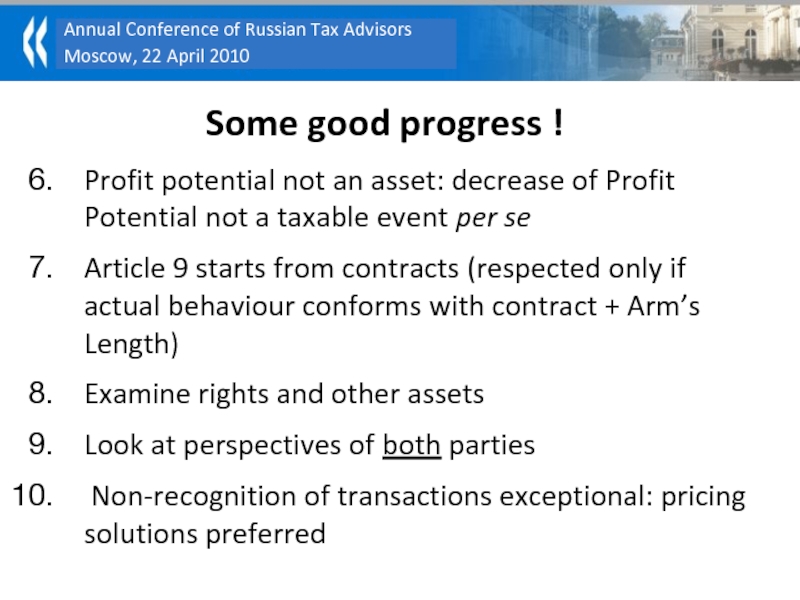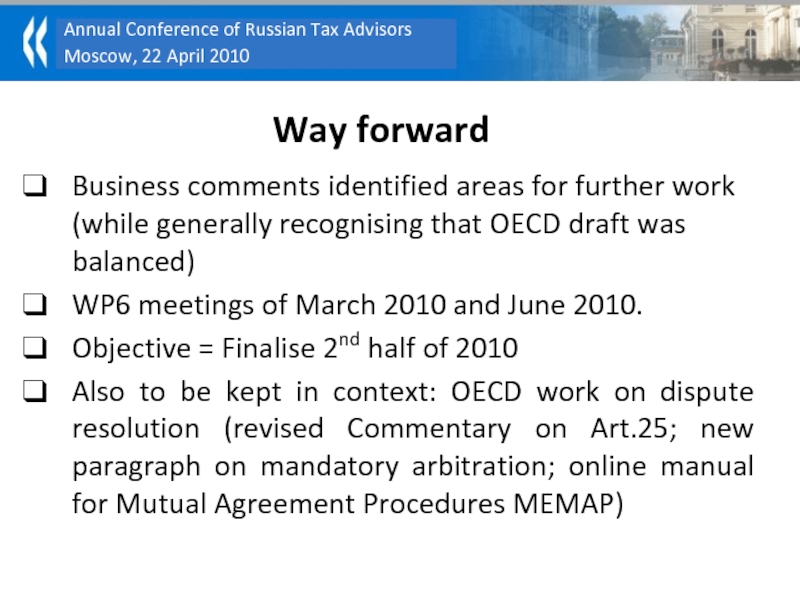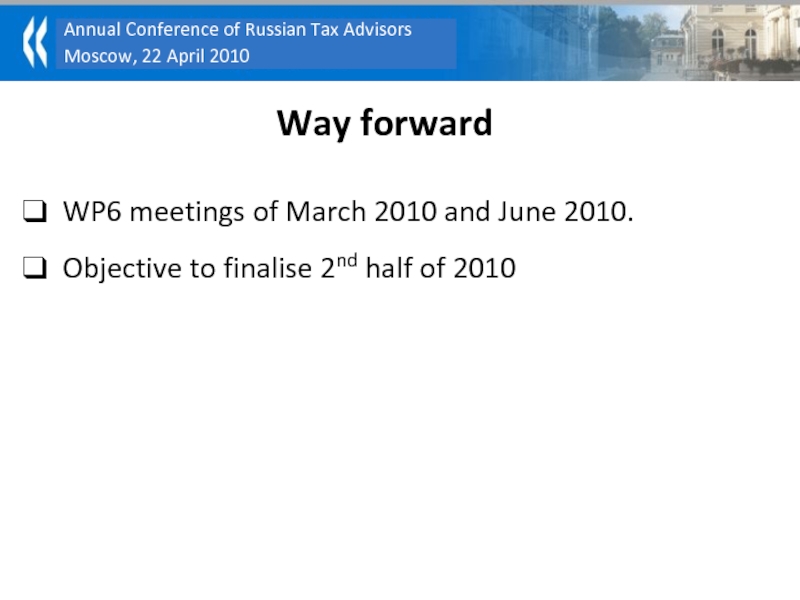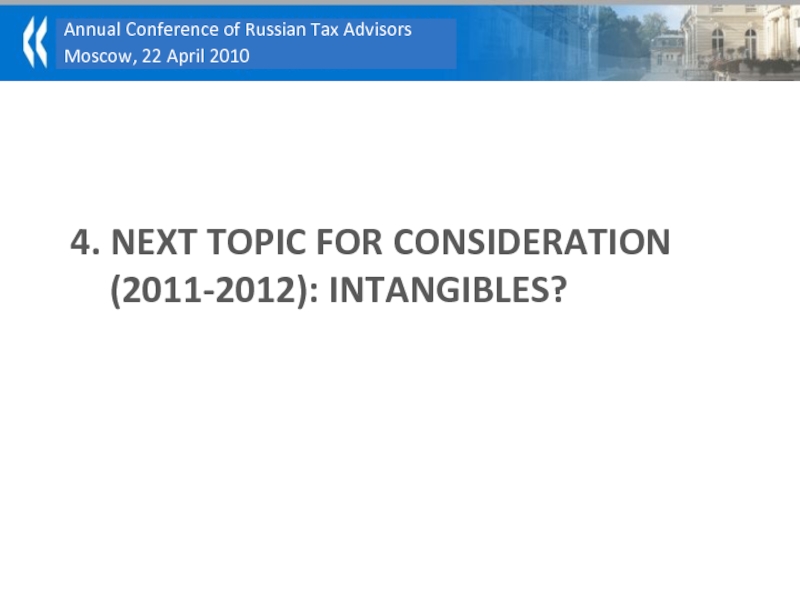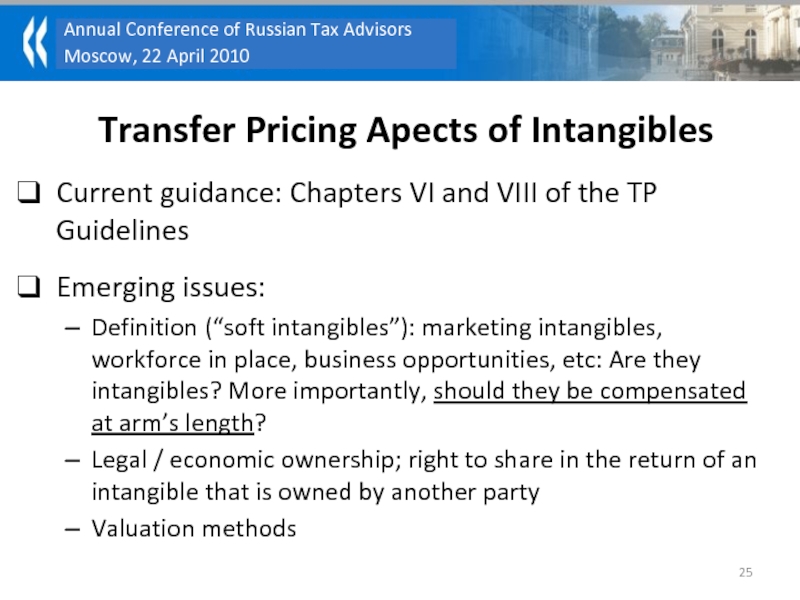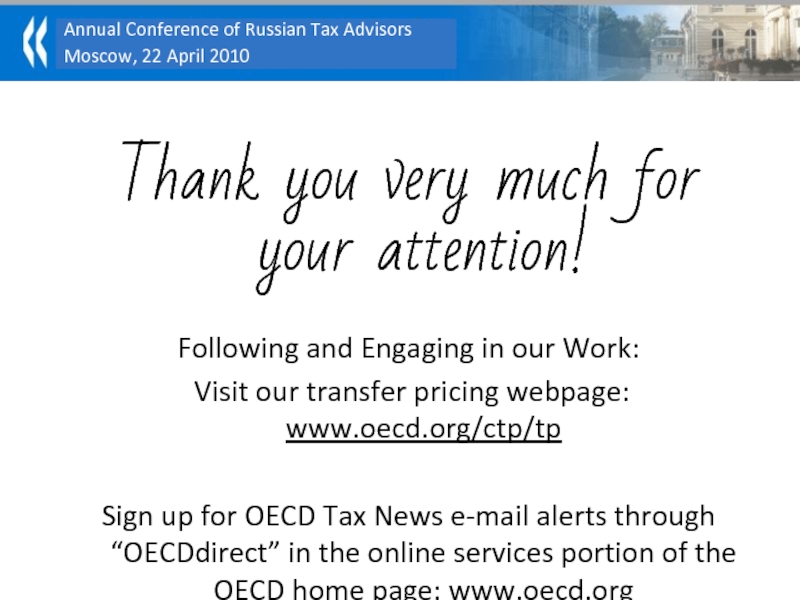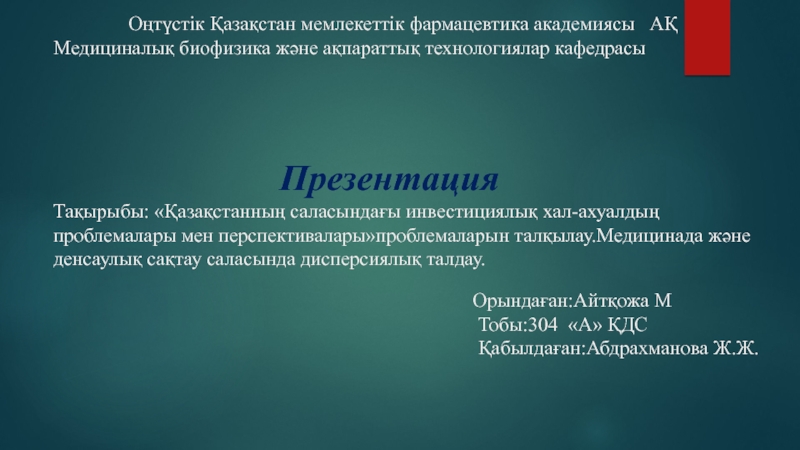Pricing and Financial Transactions Division
OECD
www.oecd.org/ctp
- Главная
- Разное
- Дизайн
- Бизнес и предпринимательство
- Аналитика
- Образование
- Развлечения
- Красота и здоровье
- Финансы
- Государство
- Путешествия
- Спорт
- Недвижимость
- Армия
- Графика
- Культурология
- Еда и кулинария
- Лингвистика
- Английский язык
- Астрономия
- Алгебра
- Биология
- География
- Детские презентации
- Информатика
- История
- Литература
- Маркетинг
- Математика
- Медицина
- Менеджмент
- Музыка
- МХК
- Немецкий язык
- ОБЖ
- Обществознание
- Окружающий мир
- Педагогика
- Русский язык
- Технология
- Физика
- Философия
- Химия
- Шаблоны, картинки для презентаций
- Экология
- Экономика
- Юриспруденция
Transfer pricing recent trends and developments at OECD презентация
Содержание
- 1. Transfer pricing recent trends and developments at OECD
- 2. Recent Developments: Attribution of profits to Permanent
- 3. 1. ATTRIBUTION OF PROFITS TO PERMANENT ESTABLISHMENTS www.oecd.org/ctp/tp/pe
- 4. In July 2008, the OECD Council approved
- 5. 2. PROPOSED REVISION OF CHAPTERS I-III OF THE TRANSFER PRICING GUIDELINES www.oecd.org/ctp/tp/cpm
- 6. Proposed revision of Chapter II – Part
- 7. Proposed Revision of Chapter II – Parts
- 8. Proposed New Chapter III Comparability Analysis: Objective:
- 9. Non-domestic comparables should not be automatically rejected Foreign comparables
- 10. Use of secret comparables discouraged Exception: in
- 11. Arm’s length range and statistical tools In
- 12. Arm’s length range and statistical tools If
- 13. Loss-making comparables Not systematically rejected Case-by-case (risk
- 14. 3 New Annexes Practical illustration of issues
- 15. 3. TRANSFER PRICING ASPECTS OF BUSINESS RESTRUCTURINGS www.oecd.org/ctp/tp/br
- 16. Relevance of the issue: Tax base erosion
- 17. Definition of business restructurings: “Cross-border redeployment
- 18. OECD Discussion Draft consists of 4 Issues
- 19. The consultation process 37 detailed contributions received
- 20. Some good progress ! More consensus than
- 21. Some good progress ! Profit potential not
- 22. Way forward Business comments identified areas for
- 23. Way forward WP6 meetings of March 2010
- 24. 4. NEXT TOPIC FOR CONSIDERATION (2011-2012): INTANGIBLES?
- 25. Transfer Pricing Apects of Intangibles Current guidance:
- 26. Thank you very much for your attention!
Слайд 1Transfer Pricing
Recent Trends and Developments
at OECD Level
Wolfgang Büttner
Senior Advisor
Tax Treaties, Transfer
Слайд 2Recent Developments:
Attribution of profits to Permanent Establishments
Revision of Chapters I-III of
the Transfer Pricing Guidelines (comparability and profit methods)
Transfer Pricing Aspects of Business Restructurings
What does the future hold?
Transfer Pricing Aspects of Business Restructurings
What does the future hold?
Слайд 4In July 2008, the OECD Council approved the final Report on
the Attribution of Profits to Permanent Establishments
Partly incorporated in the 2008 update of the OECD Model Tax Convention
Full implementation in future treaties:
New Article 7 and its Commentary to be included in the 2010 update of the MTC (discussion draft released for public comment in November 2009)
Partly incorporated in the 2008 update of the OECD Model Tax Convention
Full implementation in future treaties:
New Article 7 and its Commentary to be included in the 2010 update of the MTC (discussion draft released for public comment in November 2009)
Слайд 52. PROPOSED REVISION OF CHAPTERS I-III OF THE TRANSFER PRICING GUIDELINES
www.oecd.org/ctp/tp/cpm
Слайд 6Proposed revision of Chapter II – Part I
Selection of a transfer
pricing method:
Removes exceptionality of profit methods and replaces it with a standard whereby the selected transfer pricing method should be the “most appropriate method to the circumstances of the case”.
Determined by
Appropriateness to the nature of the transaction / functional analysis
Availability / reliability of comparables
Removes exceptionality of profit methods and replaces it with a standard whereby the selected transfer pricing method should be the “most appropriate method to the circumstances of the case”.
Determined by
Appropriateness to the nature of the transaction / functional analysis
Availability / reliability of comparables
Слайд 7Proposed Revision of Chapter II – Parts II and III
Existing Chapter
II: Traditional transaction methods (CUP, Cost Plus, Resale Price): unchanged
Existing Chapter III: Transactional Profit Methods (TNMM and Profit Split):
Further guidance on practical application
TNMM: selection and determination of the net profit margin indicator
Profit Split: determination of profit to be split and of splitting factors
Berry ratios
Existing Chapter III: Transactional Profit Methods (TNMM and Profit Split):
Further guidance on practical application
TNMM: selection and determination of the net profit margin indicator
Profit Split: determination of profit to be split and of splitting factors
Berry ratios
Слайд 8Proposed New Chapter III
Comparability Analysis:
Objective: find the most reliable comparables
No requirement
for an exhaustive search of all possible sources of comparables
Acknowledge limitations in availability of information and compliance costs
“Reasonably reliable comparables”: defined as the most reliable comparables in the circumstances of the case, keeping in mind the above limitations
Typical 10-step process to be followed to perform a comparability analysis
Acknowledge limitations in availability of information and compliance costs
“Reasonably reliable comparables”: defined as the most reliable comparables in the circumstances of the case, keeping in mind the above limitations
Typical 10-step process to be followed to perform a comparability analysis
Слайд 10Use of secret comparables discouraged
Exception: in Mutual Agreement Procedures do eliminate
double taxation
Secret comparables
Слайд 11Arm’s length range and statistical tools
In some cases it will be
possible to arrive at a single figure (e.g. price or margin)
In most cases: arm’s length range
Eliminate uncontrolled transactions (“potential comparables”) with a lesser degree of comparability than others
In most cases: arm’s length range
Eliminate uncontrolled transactions (“potential comparables”) with a lesser degree of comparability than others
Слайд 12Arm’s length range and statistical tools
If comparability defects remain that cannot
be identified and/or quantified, and are therefore not adjusted → use of statistical tools that take account of central tendency might help to enhance the reliability of the analysis
Слайд 13Loss-making comparables
Not systematically rejected
Case-by-case (risk profile in particular)
Independent enterprise would not
continue loss-making activities unless reasonable expectation of future profits
Independent enterprise would not remain loss-making indefinitely.
Where an associated enterprise remains loss-making over several years: is it providing a service to the group by maintaining a commercial presence?
Independent enterprise would not remain loss-making indefinitely.
Where an associated enterprise remains loss-making over several years: is it providing a service to the group by maintaining a commercial presence?
Слайд 143 New Annexes
Practical illustration of issues in relation to the application
of transactional profit methods
Example of working capital adjustments to improve comparability
Example of working capital adjustments to improve comparability
Слайд 16Relevance of the issue:
Tax base erosion concern for certain countries
Uncoordinated
reactions by governments, for instance:
Characterise a PE of foreign principal
Assess exit / capital gain tax upon conversion
Challenge post conversion transfer pricing
Attempt to disregard some transactions involved in the restructuring
Combine several of the above arguments
Huge stakes (potential double taxation!) and uncertainties for business
Lack of consensus
Characterise a PE of foreign principal
Assess exit / capital gain tax upon conversion
Challenge post conversion transfer pricing
Attempt to disregard some transactions involved in the restructuring
Combine several of the above arguments
Huge stakes (potential double taxation!) and uncertainties for business
Lack of consensus
Слайд 17Definition of business restructurings:
“Cross-border redeployment (transfer) by a multinational enterprise
of functions, assets and/or risks with associated profit/loss potential”
Focus: How does the arm’s length principle and TP Guidelines apply to business restructurings?
Focus: How does the arm’s length principle and TP Guidelines apply to business restructurings?
Transfer Pricing Aspects of Business Restructuring
Слайд 18OECD Discussion Draft consists of 4 Issues Notes:
Special Consideration for Risks
Arm’s
Length Compensation for the Restructuring Itself
Remuneration of Post-Restructuring Controlled Transactions
Recognition of the Actual Transactions Undertaken
Remuneration of Post-Restructuring Controlled Transactions
Recognition of the Actual Transactions Undertaken
Transfer Pricing Aspects of Business Restructuring
Слайд 19The consultation process
37 detailed contributions received from the public
(see ww.oecd.org/ctp/tp/br)
Consultation with
commentators held 9-10 June 2009
Слайд 20Some good progress !
More consensus than non-consensus
Starting point is not
abusive cases
Multinational Enterprises free to organise their business; tax administrations draw tax consequences on the basis of existing rules
Same Arm’s Length Principle of Business Restructuring and post-Business Restructuring as for others
Absence of comparables does not mean non-Arm’s Length
Multinational Enterprises free to organise their business; tax administrations draw tax consequences on the basis of existing rules
Same Arm’s Length Principle of Business Restructuring and post-Business Restructuring as for others
Absence of comparables does not mean non-Arm’s Length
Слайд 21Some good progress !
Profit potential not an asset: decrease of Profit
Potential not a taxable event per se
Article 9 starts from contracts (respected only if actual behaviour conforms with contract + Arm’s Length)
Examine rights and other assets
Look at perspectives of both parties
Non-recognition of transactions exceptional: pricing solutions preferred
Article 9 starts from contracts (respected only if actual behaviour conforms with contract + Arm’s Length)
Examine rights and other assets
Look at perspectives of both parties
Non-recognition of transactions exceptional: pricing solutions preferred
Слайд 22Way forward
Business comments identified areas for further work (while generally recognising
that OECD draft was balanced)
WP6 meetings of March 2010 and June 2010.
Objective = Finalise 2nd half of 2010
Also to be kept in context: OECD work on dispute resolution (revised Commentary on Art.25; new paragraph on mandatory arbitration; online manual for Mutual Agreement Procedures MEMAP)
WP6 meetings of March 2010 and June 2010.
Objective = Finalise 2nd half of 2010
Also to be kept in context: OECD work on dispute resolution (revised Commentary on Art.25; new paragraph on mandatory arbitration; online manual for Mutual Agreement Procedures MEMAP)
Слайд 25Transfer Pricing Apects of Intangibles
Current guidance: Chapters VI and VIII of
the TP Guidelines
Emerging issues:
Definition (“soft intangibles”): marketing intangibles, workforce in place, business opportunities, etc: Are they intangibles? More importantly, should they be compensated at arm’s length?
Legal / economic ownership; right to share in the return of an intangible that is owned by another party
Valuation methods
Emerging issues:
Definition (“soft intangibles”): marketing intangibles, workforce in place, business opportunities, etc: Are they intangibles? More importantly, should they be compensated at arm’s length?
Legal / economic ownership; right to share in the return of an intangible that is owned by another party
Valuation methods
Слайд 26Thank you very much for your attention!
Following and Engaging in our
Work:
Visit our transfer pricing webpage: www.oecd.org/ctp/tp
Sign up for OECD Tax News e-mail alerts through “OECDdirect” in the online services portion of the OECD home page: www.oecd.org
Visit our transfer pricing webpage: www.oecd.org/ctp/tp
Sign up for OECD Tax News e-mail alerts through “OECDdirect” in the online services portion of the OECD home page: www.oecd.org

